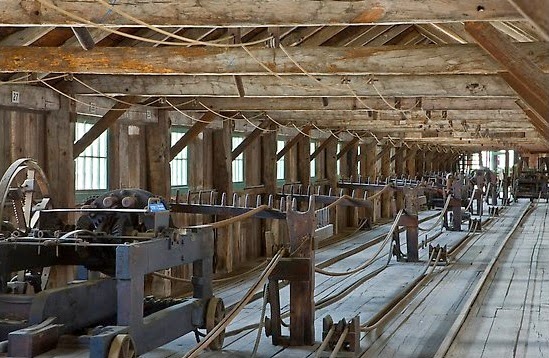The true origins of the
craft of rope making are lost in history, but there is fossil evidence of rope
usage dating back to 17000BC. These
early ropes were likely
to be long pieces of vine twisted or braided together by hand. The ancient
Egyptians were most likely the first civilization to develop tools for
constructing ropes around 4000BC. Such ropes would have been made out of
grass, water reeds or animal hair. These ropes would have been used by the
Egyptians in constructing their colossal structures such as the pyramids that
still stand today. Hemp fibres were first used to make ropes by the Chinese
around 2800BC and after this, rope making spread throughout the rest of Asia
and to Europe.
In Europe, twisted rope has been hand-made using the
ropewalk method since the Middle Ages and by the late 1700s advances in technology meant that several
machines for making rope had been constructed. Ropewalks were harsh working
environments and would often catch fire as they were made mainly of wood and
hemp dust can create an explosive mixture. Natural fibre yarns would be twisted
to form strands which would spread the length of the building. These would then
be counter-twisted to form the rope. The length of the walk
would limit the length of rope that could be made but this allowed for ropes to be as long
as 300 yards for use on sailing ships, for which they were essential. The
standard length for a British Naval Rope was 1000 feet and a sailing ship
such as HMS Victory would
require over 20 miles of rope.
 |
| A Typical Early Ropewalk |
Braided cords have also been around for centuries, but up until the 1800s they had all been braided by hand. When automatic braiding machines were invented in the Victorian era, rope factories became capable of producing high volumes of braided cords. Braiding machines were initially used for smaller cords and laces but the development of larger braiding machines meant that by the middle of the Twentieth Century the production of braided rope became widespread.
Prior to the
development of nylon by the laboratories of E. I. Dupont de Nemours in 1939,
the only materials that were available to cordage manufacturers were natural
fibres. The development of polyester and polypropylene followed in the 1940s
and 50s and this revolutionized the textile and cordage industries. These developments meant that alongside the
traditional natural fibres of manila, sisal, hemp, flax, cotton and jute, ropes
today are more commonly made from nylon, polypropylene, polyethylene and
polyester. This is because synthetic ropes are generally stronger, lighter and
more hardwearing than the natural alternatives. You can find a wide range of both natural and synthetic, twisted and braided ropes here.
